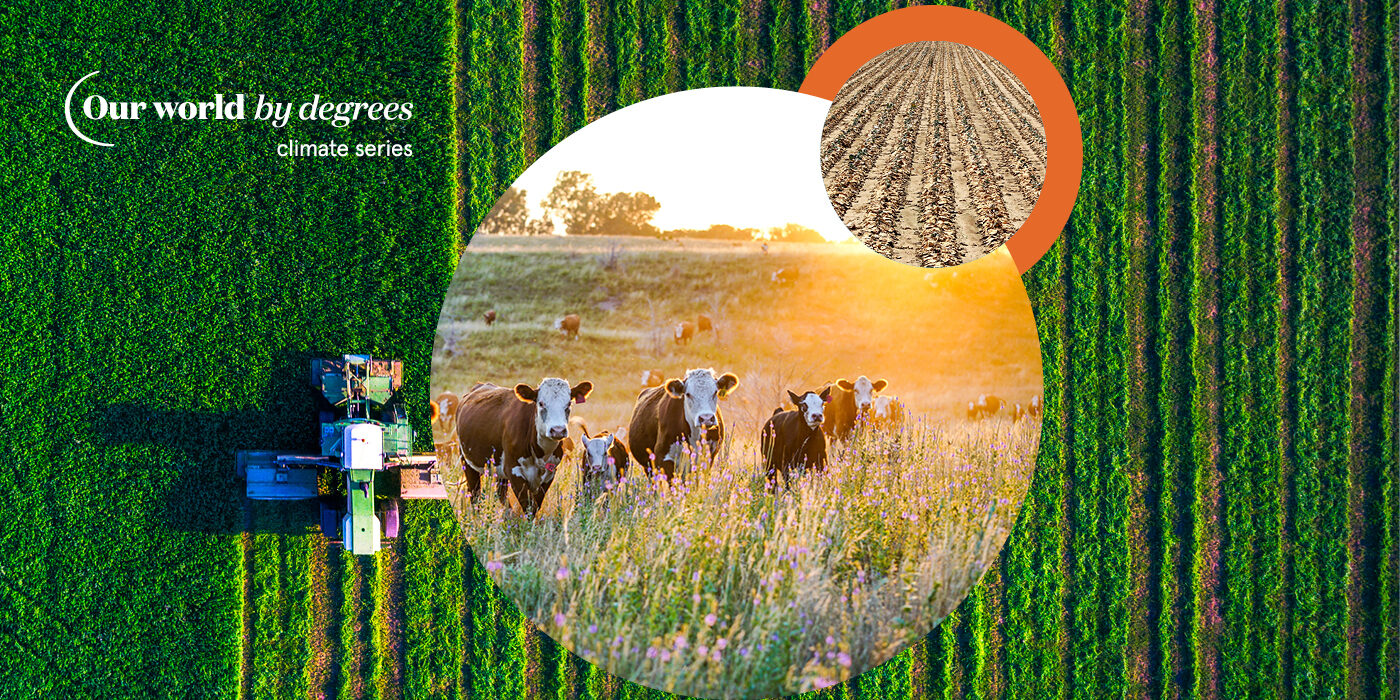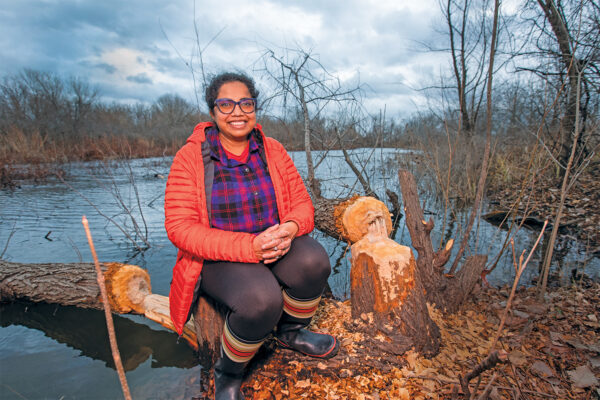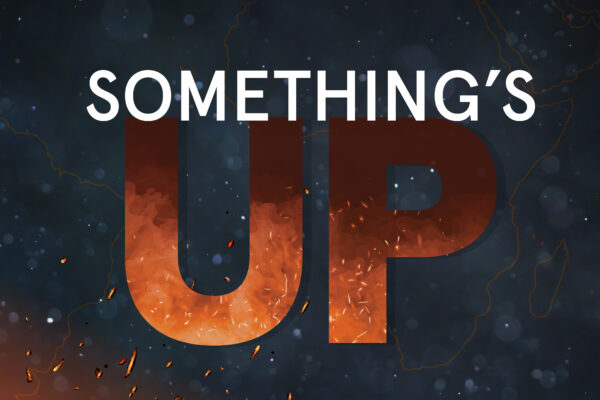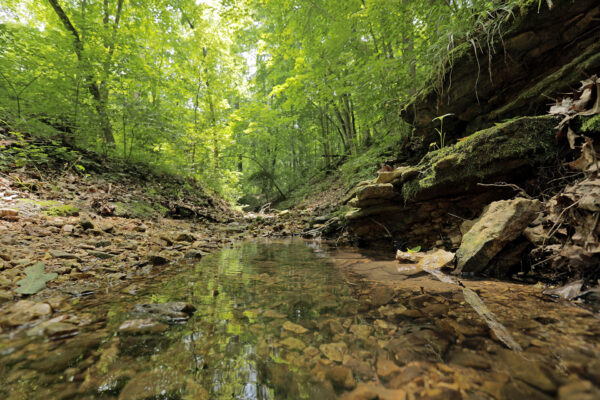The impacts of climate change will be felt around the world, not only in Arctic and Antarctic regions or along the coasts.
In fact, things are already changing locally. In the 12 states that make up the Midwest, temperatures have been warming at an accelerating rate in recent decades, particularly nighttime and winter temperatures.
Midwest winters are becoming warmer and wetter. Future springs may feature heavier precipitation and related flooding. Summers are likely to be hotter, with longer dry periods between rains.
While some of these changes could lead to higher yields of certain crops in the short term, the U.S. Environmental Protection Agency and others believe that these and other climate-related stressors are likely to decrease yields of important agricultural crops over time.
Climate change is expected to negatively affect human health in the Midwest in a variety of ways, including exacerbating existing health challenges. We will see more heat waves and related heat stress, reduced air quality and increased allergens.
To counter these effects and help build a more climate-resilient future, Washington University in St. Louis has taken a leadership role in developing, launching and implementing the Midwest Climate Collaborative.
Launched in spring 2022, the Midwest Climate Collaborative and its members are developing a cohesive Midwestern response to the climate crisis.
Launched in spring 2022, the Midwest Climate Collaborative and its members are developing a cohesive Midwestern response to the climate crisis. The collaborative includes influential city governments, large research universities and small liberal arts schools, nonprofits focusing on human health and the environment, private companies and others.
No such alliance exists along the coasts, in the South or in New England. The approach is unique in the nation. But so are the climate-related challenges and opportunities for the Midwest.
Heather Navarro, appointed this year as the inaugural director of the Midwest Climate Collaborative, says: “Issues of climate change aren’t defined by city or state boundaries. I can’t think of a better way to address the climate crisis than from a regional perspective, with diverse partners collaborating from the idea stage to design and implementation.”
A former St. Louis alderwoman, Navarro is a WashU graduate who earned a bachelor’s degree in environmental studies from Arts & Sciences and a JD from the School of Law.
“The only way we will protect our communities for the long term from climate change is through interdisciplinary collaboration,” says Navarro, AB ’01, JD ’08.
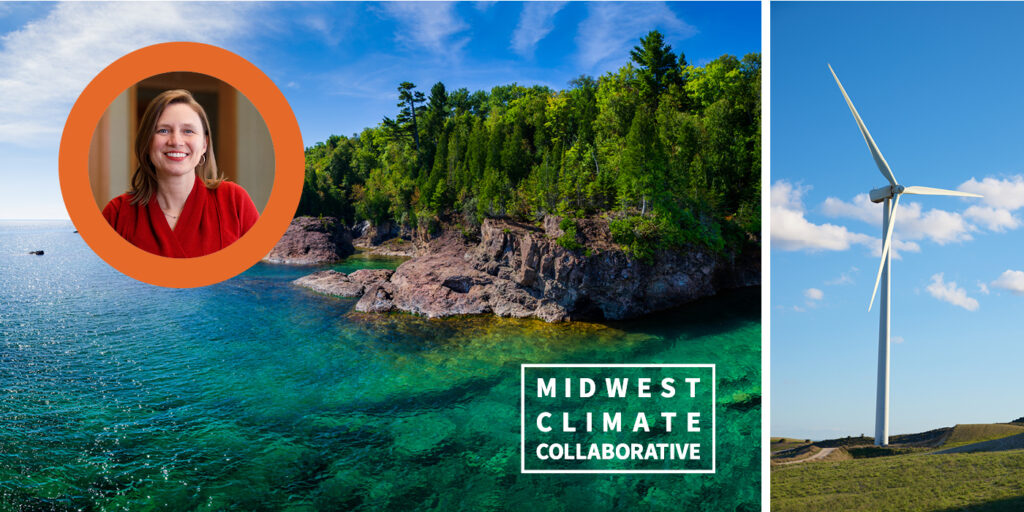
A Midwestern focus
If the 12 states making up the Midwest were a country, they would be the fifth-largest greenhouse gas–emitting nation in the world. The vast majority of these emissions come from burning coal for energy. Agriculture — one of the biggest drivers of local economies in the Midwest, accounting for billions of dollars’ worth of exports and thousands of jobs — also contributes to regional greenhouse gas emissions.
Many Midwestern cities — current and former manufacturing hubs — now suffer from aging and energy-inefficient infrastructure. And longstanding racial and economic inequalities mean that minority communities bear a disproportionate share of the negative impacts of climate change in the Midwest.
But there are also many bright spots and areas of strength. One example: The Great Lakes contain 84% of North America’s surface freshwater and provide drinking water to more than 40 million people. It’s crucial to protect such Midwestern natural resources. The region is also home to hundreds of thousands of acres of climate-preserving forests, and certain of its wide-open spaces seem ripe for wind and solar energy installation.
The human capital is here, too. Universities such as those that make up the Big Ten Academic Alliance as well as major private universities like Washington University contribute to the Midwest’s academic research punch. And for private industry, nearly 150 Fortune 500 companies were founded or have headquarters in the Midwest.
The idea for the Midwest Climate Collaborative was born against this backdrop. And with a strong leader at its helm, this cross-sector collaborative is poised to accelerate climate action and research for the good of the region and the world.
Accelerating change
The desire to bring together a Midwest-based group of partners with shared interests in climate research and action was born more than three years ago.
In fall 2020, Washington University, with the support of Bloomberg Philanthropies, led the charge in planning and convening the Midwest Climate Summit, a first-of-its-kind event. An estimated 1,300 people, including many undergraduates, participated in the summit and its accompanying think tank sessions.
The summit incorporated cross-sector, high-level discussions involving a key group of organizations committed to advancing climate measures in the Midwest. Over the next months, several additional think tank sessions followed, with members networking with one another in between meetings. It became clear that there was a strong interest in long-term collaboration to pursue further climate work.
All these efforts culminated in January 2022 with the Midwest Climate Collaborative (MCC) during a virtual event. Washington University was among the 30 founding members announced at the event (members number more than 40 now).
“We can’t wait to see the measurable steps this group will take, together, to make the Midwest a more resilient, sustainable and prosperous place to live, work and play for everyone,” says David Fike, director of the International Center for Energy, Environment and Sustainability (InCEES), director of the environmental studies program, and professor of earth and planetary sciences in Arts & Sciences at Washington University.
Collaborative members include universities like Ohio State, Indiana University and Carleton College; the cities of Ann Arbor (Michigan), Columbus (Ohio) and Kansas City; nonprofits like The Nature Conservancy in Illinois; and private companies like MilliporeSigma. About one-third of them hail from the St. Louis region, including the Saint Louis Zoo, Missouri Botanical Garden and Missouri Historical Society.
“In this first year, the No. 1 priority is connecting,” Navarro says. “We are a collaborative, and this networking function is going to be very important. People have to feel invested in the relationship, not just with me and with the collaborative, but also with one another.”
Coming home to climate advocacy
Washington University was Navarro’s first choice — three times.
Neither of her parents attended a four-year college. But Navarro, who grew up in Bloomington-Normal, Illinois, wanted to pursue a degree and was interested in environmental work, even as a teenager. When she heard about the Hewlett Program (now called the Pathfinder Fellows in Environmental Leadership Program), she decided that Washington University was the school for her.
“Heather is an excellent choice to head the Midwest Climate Collaborative,” says Bill Lowry, emeritus professor of political science in Arts & Sciences and a former leader of Washington University’s Sustainability Exchange program, who served as Navarro’s undergraduate adviser. “I’ve known her for a long time, and she has always shown strong leadership skills as well as a sincere concern for the larger community.”
Navarro was only four days into her new job when she first addressed collaborative members and other interested parties at the launch event.
“It feels very much like coming full circle,” says Navarro, who also mentions Ray Arvidson, the James S. McDonnell Distinguished University Professor Emeritus, who designed and led the Pathfinder Program, and Glenn Stone, professor of sociocultural anthropology and environmental studies, both in Arts & Sciences, as teachers who played influential roles in her undergraduate career. “It was an interdisciplinary approach to the environment that launched everything for me. And now, here I am, leading an interdisciplinary climate collaborative.”
“Success in the Midwest will look different from success in other parts of the country, and that’s what makes this collaborative one of a kind… We only have to look around at one another to start seeing what’s possible when we act collectively.”
Heather Navarro
The second time Navarro picked WashU was for law school. After graduating with a bachelor’s degree in 2001, Navarro spent a year volunteering as a social justice coordinator with the Catholic Student Center on campus and then traveled to Guatemala. She moved back to St. Louis to start her family. Navarro then enrolled in the School of Law and graduated in 2008.
Prior to her work with the Midwest Climate Collaborative, Navarro served four years on the St. Louis Board of Aldermen, where she supported climate initiatives, including working with Washington University to help achieve the city’s ambitious clean energy and energy efficiency goals made through Bloomberg Philanthropies’ American Cities Climate Challenge. Navarro sponsored successful city ordinances implementing solar-ready and EV-ready requirements for new construction and Building Performance Standards.
Previously the executive director of the Missouri Coalition for the Environment — a statewide environmental advocacy organization — Navarro is energized by the new opportunities the MCC offers for working with people in many different spheres and locations across the entire Midwest.
“One thing I hope I can bring to folks is to say, ‘You’re not alone,’” Navarro says. And she hopes to share a sense of the promise and possibilities: “‘I want you to see what I see — to see what’s possible if we’re able to tell this collective story,’” she adds.
WashU’s Lowry agrees. “The Midwest Climate Collaborative could be an important organization for at least two big reasons,” he says. “First, much needs to be done in the Midwest. So much Midwestern activity, such as reliance on coal, affects the climate. Second, there is great potential to encourage collaboration throughout the entire Midwest between scientists, researchers, stakeholders and institutions like Washington University.”
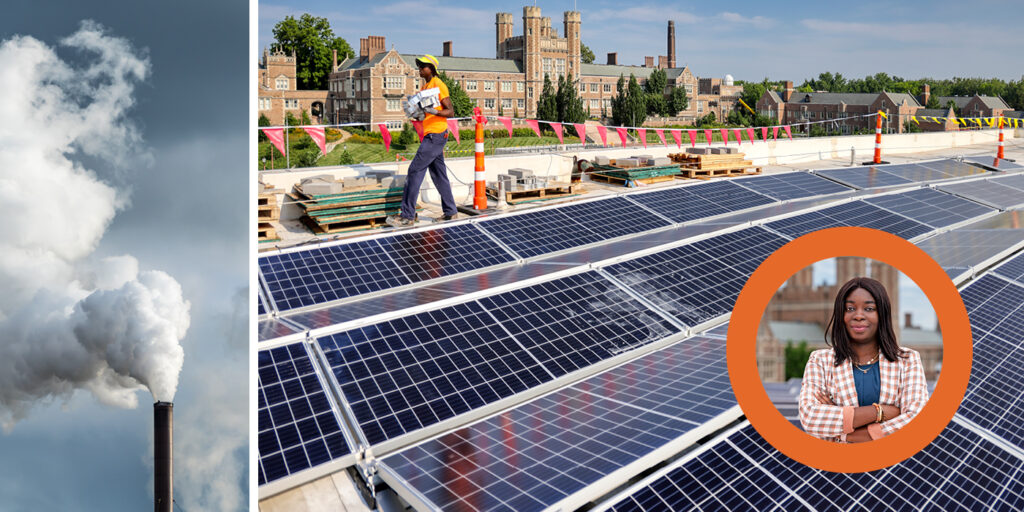
Empowering groups to act on research
One of the first things that MCC organizers are doing is working to develop a cohesive and shared climate research agenda.
Abigail Aderonmu, a postdoctoral research associate with WashU’s InCEES, is the point person for this effort.
“The research agenda aims to bridge the gap between research and practice, as well as listening to and understanding questions and challenges from practitioners and researchers.”
Abigail Aderonmu
“The research agenda aims to bridge the gap between research and practice, as well as listening to and understanding questions and challenges from practitioners and researchers,” Aderonmu says.
Aderonmu is reaching out to other scientists, municipal leaders, academics, farmers, business leaders, NGOs and others to explain what the Midwest Climate Collaborative is doing and to encourage people to describe their climate-related research questions. She is collecting these questions using an online portal that she helped develop. And she’s been hitting the road to outreach events this summer to help get the word out.
Consider just a few examples of the range of questions the team will evaluate as they work to develop the larger, cohesive research agenda:
- How can we do a better job of opening market access to historically marginalized communities that wish to participate in the advanced energy economy (e.g., rooftop solar, electric vehicles, energy storage)?
- How effective are ecological corridors, such as those that now exist or are proposed, at facilitating the migration of a range of native species?
- What are the most effective strategies to reduce carbon emissions in the Midwest, as evaluated by potential impact (total carbon reduction potential), cost per unit of carbon, ease of implementation, etc.?
MCC organizers also want to know what it will take to empower community groups and local governments to act on existing or future research findings.
Aderonmu plans to organize a workshop to review the questions generated over the course of months of outreach. The third and final phase of this project is the publication and distribution of the key questions.
“One thing that’s standing out in the process of developing the research agenda,” Aderonmu says, “is the enthusiasm and interest of a variety of stakeholders in having a bottom-up, collaborative approach to addressing climate-related issues in the Midwest.”
Climate and community
The Midwest Climate Collaborative is also initiating other local projects.
Education is a critical piece of the puzzle that will help enable the Midwest to lower emissions, create a thriving green economy and ensure a just and equitable transition to a more climate-friendly way of living — without leaving rural, suburban, urban or indigenous communities behind. The MCC is developing an educator community of practice to share effective practices, models and materials for creating this future.
Beth Martin, teaching professor in environmental studies in Arts & Sciences and director of WashU’s Climate Change Program, helped organize and lead workshops for educators in the Midwest, just held in the spring. A student-focused Midwest climate and sustainability conference also was held in the spring.
Another initial project is focused on developing an asset map and interactive database of Midwestern climate work. The map project will help users easily access, use and contribute to local information around climate action.
Finally, a new climate ambassadors program aimed at faculty, postdoctoral fellows and professional and graduate students will provide training in science communication and community engagement.
Taken together, these initial projects represent an ambitious start for the Midwest Climate Collaborative, with much more work to come. Organizers say they are up for the challenges ahead.
“Success in the Midwest will look different from success in other parts of the country, and that’s what makes this collaborative one of a kind,” Navarro says. “Here, we are poised to take on the climate crisis, and we only have to look around at one another to start seeing what’s possible when we act collectively.”
